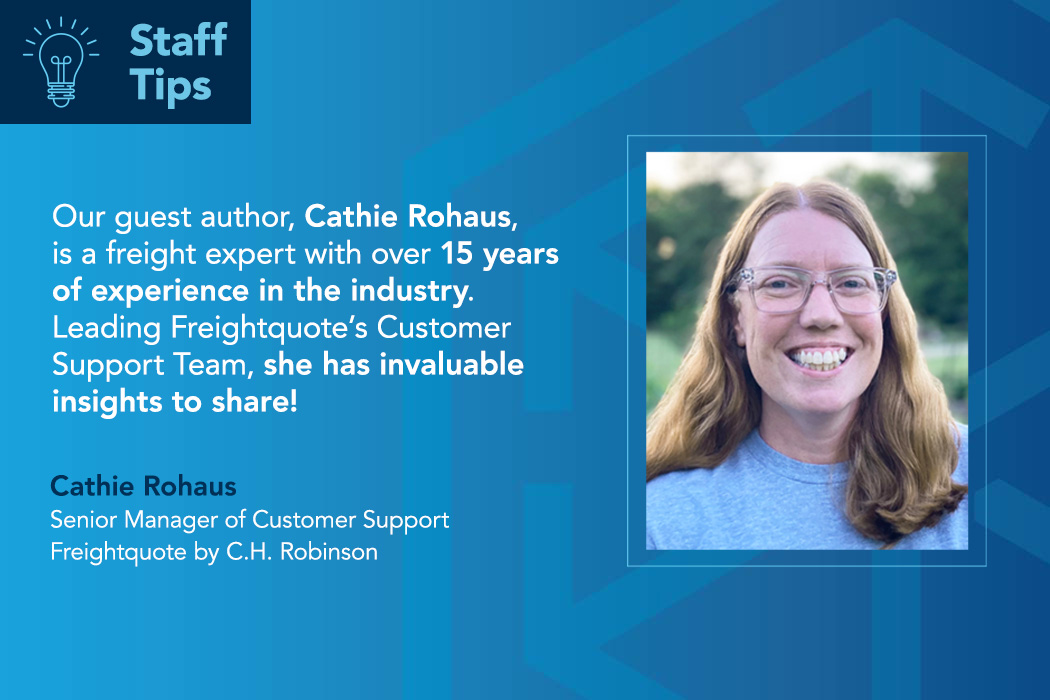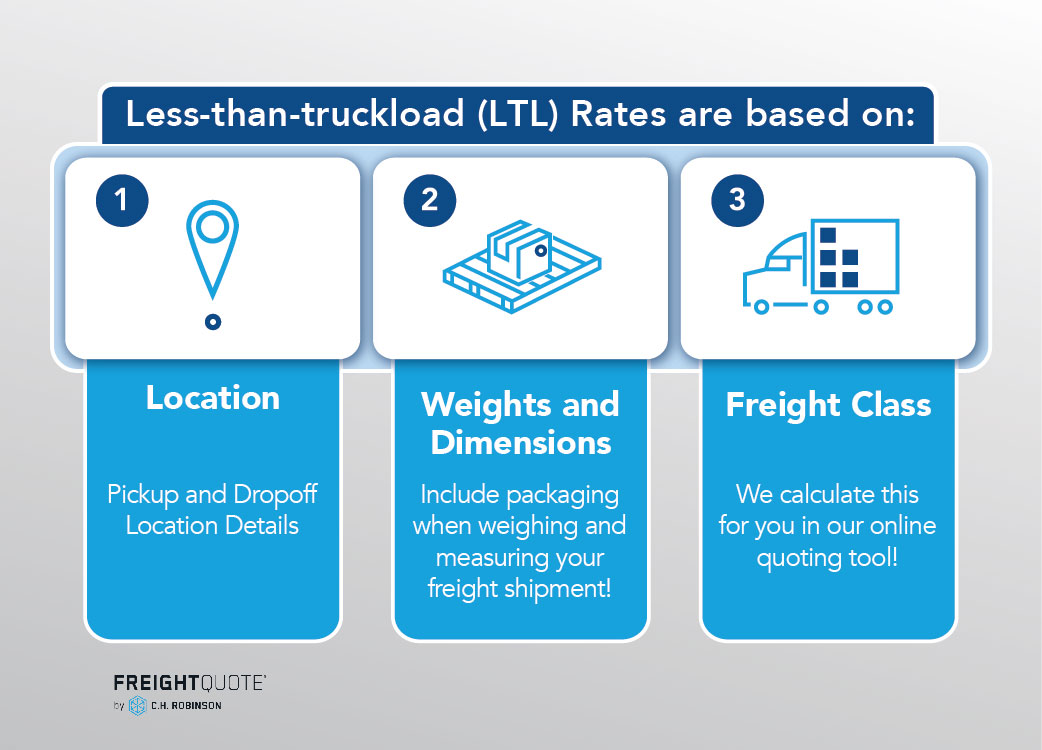Guest Blog: How LTL Freight Pricing is Determined
July 25, 2024

Wondering how to sort out all the factors that go into less-than-truckload (LTL) shipping? Our experts have you covered! This month’s guest blogger, Cathie Rohaus, Freightquote’s Senior Manager of Customer Support, is here to clear up the complications and help you make quoting your LTL freight easy.
Diving into the world of freight rates and LTL pricing can be an intimidating experience. In an age where small packages are delivered around the world 24/7, it's easy to develop certain expectations about shipping without even realizing we've done so.
At some point, most of us have gone online and made a purchase that was then shipped directly to our home. We're used to going online to pick out new shoes, for example, then entering our address and instantly seeing a price for shipping. This kind of small parcel pricing is easy to understand. You can pay a smaller fee for a standard transit or a higher fee for faster delivery. You might even see options for free shipping if you pick up your item at a store, increase the number of items or dollar amount in the order, or subscribe to reoccurring orders. These options mean the toughest decision you have to make is whether you really need the cute socks you were eyeing!
The first time you find yourself in need of quoting a freight shipment, you will quickly learn not all shipping is quite so straightforward. A quick internet search will introduce you to a variety of factors that go into less-than-truckload (LTL) pricing. Depending on the source, you might see that LTL prices are determined by: size, weight, distance, type of product, freight classification, accessorials, tariff discounts, density, and more. While these things do all matter when it comes to your final shipping total, they are not as scary as they sound.
The information needed to get a basic, accurate LTL pricing can be grouped into 3 easy to understand categories:
1. Locations
2. Weight and dimensions
3. Freight class
I’ll break these down into a little more detail below, but it’s really that simple!

Three factors determining basic LTL freight pricing
1. Location, location, location
The easiest part of this requirement is knowing your pickup and delivery addresses. As you might expect, distance does matter. A shipment traveling from New York to California must cover a lot of ground, so it will cost more than a shipment moving across your home state.
What can be surprising about location is that the standard base rate of any LTL freight shipment includes pickup and delivery to only business locations that have no extra services or location restrictions. Specifically, here's what "standard business location" means to most LTL carriers:
- Location must load or unload the truck without any driver assistance
- Loading or unloading must take no more than 15 minutes from the time the truck arrives on the property to the time the truck exits the property
- Location is in an easily accessible commercial area with no surrounding weight or height limitations on trucks
- Location cannot require the driver to pass through gates, ring bells, call ahead of arrival, wait in lines, or otherwise delay entry into or out of the location
Any services or location needs outside of the above will require prior notice and additional fees to be performed by an LTL carrier. You can enter those services when you get a quote, so there won’t be any surprises later. For a bonus freight term, those additional services and fees are called accessorials.
Special services or non-business locations will require prior notice and additional fees to be performed by an LTL carrier.
If this sounds like carriers are trying to nickel and dime customers for something as simple as a phone call, rest assured that these rules are in place for good reason. Carriers are simply trying to be as efficient as possible and provide the best rates for shipments that can be moved quickly and efficiently.
To go back to our shoes example, if you order custom sneakers that are hand-stitched with rainbow laces you would expect to pay a premium for the order since it takes more resources and time to create.
The same concepts apply in LTL freight. Substituting a business location with a residential one comes with a fee because those locations are typically outside a driver's normal commercial routes, making them more time consuming to reach and/or taking special, smaller trucks to access. Adding a liftgate to your pickup location costs more because it takes specialized equipment that is in shorter supply than a typical full size semi-trailer. Any accessorial can follow the same simple logic: it either takes more time, specialized equipment, or both. Make sure to enter those additional needs when you quote your shipment so they’ll be factored in to your cost up front.
Accessorials can follow the same logic: it either takes more time, specialized equipment, or both.
What can be confusing is that most LTL carriers charge different rates for each of these accessorial services. One carrier may charge $25 to schedule a delivery appointment, while another does this for free. On top of that, when you call some carriers directly for a quote, they give you an all-inclusive rate without a breakdown of what each service costs. If your shipment needs several special services, keeping things straight can quickly make your head spin.
This is where you'll be glad you found Freightquote! Simply enter in your shipment details and our online quoting tool gives you side-by-side comparison of multiple carriers so you can choose the carrier with the services you need at the best prices in the industry. Even better, we always offer transparent LTL freight pricing with line-item detail for each service you request.
2. Weights and dimensions
Luckily, these details are exactly what they sound like. The carrier simply needs to know how much your shipment weighs and how much space it will take up on their truck. Because LTL carriers will move each shipment off and onto multiple trucks, they need the weight and dimensions of each piece in the shipment.
The weight and space your shipment takes up in the truck is what's important.
For another bonus term, these pieces are referred to as handling units and are the packaged unit or container the carrier will be moving around.
Handling units are important because they include the commodity (product or goods) being shipped and the packaging materials used to keep everything safe. Since a carrier is moving the entire handling unit, the size and weight of it are what helps determine the price for the shipment.
To put this into practice, when a shoe manufacturer sends 200 pairs of shoes to a local retailer, they don't ship 200 loose shoe boxes. Instead, they package the 200 boxes onto a single pallet, which then becomes the handling unit. To get a quick LTL price, the warehouse will weigh and measure the entire handling unit. Remember, the weight and space your shipment takes up in the truck is what's important—so when measuring make sure to include all containers and packaging materials the carrier will be hauling around.
3. Freight class
Freight class is arguably one of the more intimidating aspects of LTL pricing. Traditionally, freight classification is determined by the National Motor Freight Traffic Association (NMFTA), which standardizes all commodities into 18 different classes ranging from 50 (least expensive) to 500 (most expensive). Classification of each commodity is determined by 4 main factors: density, stowability, handling, and liability.
While this traditional method of classification certainly still exists throughout the LTL industry, carriers are now widely accepting dimensional freight classes, which are based on a shipment's density (a ratio of weight to volume).
Here at Freightquote® by C.H. Robinson, we found the traditional freight classification system so cumbersome for our customers we created an online quoting tool that eliminates the need for it!
Skip the math—our free online tool automatically calculates your freight class.
Instead, our tool uses the weight and dimensions of handling units to determine the shipment's density and then automatically assigns a dimensional freight class. This allows our LTL carriers to populate accurate prices instantly on our site and prevents our customers from having to jump through any extra hoops just to get a freight rate.
If you're interested in learning more about how our tool calculates density and dimensional freight class, you can check out our freight class calculator.
Rely on Freightquote for transparent, accurate LTL freight pricing
Now that we’ve solved for some of the common challenges in securing accurate LTL rates, getting LTL pricing is easy. Once you enter the details of your shipment into Freightquote's quoting tool you'll be presented with a list of carrier options, which makes your pricing as simple as getting those shoes delivered to you. You’ll see options for standard, expedited, and guaranteed services when available, and you can rest easy knowing every option is covered by our Lowest Price Guarantee.
If you want to learn more about LTL shipping, check out our other videos and blogs for more on this as well as other topics to help with reliable small business shipping. When you’re ready to ship, Freightquote is here with tons of helpful tips and information about how you can get accurate quotes, seamless shipments, and real-time updates about your freight.
